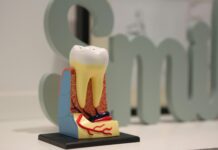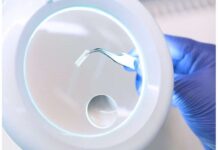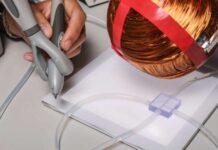Case Report
Obturator hernias are extremely rare, accounting for less than 1% of all abdominal wall hernias. The condition is more prevalent in old, thin, and multiparous women. Patients frequently seek medical attention for symptoms of intestinal obstruction such as stomach pain, nausea, and vomiting. The Howship-Romberg sign is a distinct symptom. That appears as pain along the inner thigh that may radiate to the knee when the patient coughs, strains, or performs passive abduction or external rotation on the hip joint.
However, this symptom is only seen in a few cases. The clinical presentation of this condition is frequently atypical, resulting in delays in diagnosis and therapy. Elderly patients usually have many underlying illnesses, which complicates perioperative care. Additionally, the high incidence of intestinal strangulation heightens the hazards. These interacting factors considerably enhance patients’ death risk. According to reports, the overall mortality rate for obturator hernia might reach 47.6%.
Although the impact of computed tomography (CT) scans on lowering complications and death in obturator hernia patients is debatable. They can enhance diagnostic accuracy and help surgeons assess intestinal viability preoperatively, allowing for better surgical planning. CT scans are very useful in cases of diagnostic ambiguity.
Case Presentation
This is a case report of an 80-year-old Chinese woman who began experiencing occasional pain in her inner left leg and knee two years ago. The pain frequently happened while activities and was eased by lying down and resting. Three hours ago, after physical activity, she suddenly experienced intense pain and limited movement of her left limb. She had no complaints of abdominal pain, nausea, or vomiting. The patient has a history of constipation and bronchiectasis, has recently coughed but produced no sputum, and denies any other chronic medical issues. Her obstetric history shows three previous vaginal deliveries.
Examination
Because of the obvious left lower limb pain, the emergency department colleagues first did a vascular ultrasound to rule out an acute vascular embolism. The ultrasonography detected thrombosis in the left calf’s intermuscular veins. The patient was then sent to our Department of Vascular and Hernia Surgery.
Physical examination: T 37.3 °C, P 90 bpm, R 18 bpm, blood pressure 135/66 mmHg, BMI 18.7 kg/m2. There was no substantial swelling in the lower extremities. The Homans sign test was halted since the patient complained of aggravated pain in the inner left thigh when moving the lower limb. Further examination of the left thigh, left inguinal region, and perineal area revealed no palpable lumps. The flesh on the inside left thigh became numb. Abdominal palpation revealed discomfort in the lower left quadrant but no rebound soreness. After ruling out the likelihood of lower-limb pain caused by intermuscular venous thrombosis, the patient received an emergency abdominal CT scan.
Investigation
CT imaging indicated a hernial sac positioned between the left obturator externus muscle and the pectineus muscle, which included small intestine, confirming the diagnosis of a left incarcerated obturator hernia.
After adequately telling the patient about the dangers and getting informed consent, he had emergency laparoscopic exploration under general anesthesia. A laparoscopic examination revealed a left obturator hernia with incarcerated small intestine. To our astonishment, the patient had both an ipsilateral inguinal and femoral hernia, as well as a contralateral obturator and femoral hernia. First, the incarcerated bowel was removed laparoscopically, and there were no evidence of rupture or necrosis in the incarcerated segment.
After informing the patient’s proxy of the condition and taking into account that prolonged anesthesia time for bilateral surgery would increase the risk of postoperative ventilation and thrombotic complications, it was decided to treat the right-sided hernia later, with the patient’s proxy’s informed consent. The procedure involved laparoscopic transabdominal preperitoneal repair with a 15 × 10.4 cm monofilament polypropylene three-dimensional (3D) mesh covering the myopectineal opening. The mesh was repaired, and the peritoneum was sutured. The surgery lasted 80 minutes, and the patient’s vital signs were steady throughout.
Post Operative Period:
Following surgery, the patient reported great alleviation from left leg pain, and a follow-up lower limb vascular ultrasonography revealed no significant advancement of the thrombosis. Following a thorough evaluation of thrombotic and bleeding risks, the patient was given preventive anticoagulation treatment. The patient began oral intake on the second postoperative day and was released on the fifth day. A repeat lower limb venous ultrasonography on the day of discharge confirmed that the thrombosis had been completely resolved.
The patient was instructed to avoid rigorous exercise and severe physical labor after surgery, instead opting for moderate daily activities to enhance intestinal function recovery and prevent lower limb venous thrombosis. In addition, a hernia belt was recommended for further protection.
To avoid constipation and lessen intra-abdominal pressure changes, a protein and fiber-rich diet was recommended. Regular visits to the pulmonary department were recommended to treat coughing problems, and incision cleanliness and healing were stressed. The one-year postoperative follow-up revealed no recurrence of the hernia, no lower limb pain, great wound healing, and complete self-sufficiency in daily life, indicating an overall ideal recovery. The patient also intends to have surgery for the right-sided hernia in the near future.



